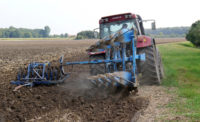 Female farmworkers in the U.S. get acute pesticide-related illnesses and injuries at twice the rate of male farmworkers, according to researchers from the National Institute for Occupational Safety and Health (NIOSH).
Female farmworkers in the U.S. get acute pesticide-related illnesses and injuries at twice the rate of male farmworkers, according to researchers from the National Institute for Occupational Safety and Health (NIOSH).
Their paper "Gender differences in acute pesticide-related illnesses and injuries among farmworkers in the United States, 1998–2007," is posted online and explains that the gender difference in rates is confined to farmworkers who don’t directly handle pesticides.
Most farmworkers (86%) do not directly handle pesticides and have little or no control over many of the contributing factors that lead to their acute pesticide-related illness such as exposure to off-target pesticide drift, early re-entry into pesticide-treated areas, and being present in the treated area at the time of the pesticide application. While female "non-handlers" appear to be at an increased risk, the total number of farmworkers with acute pesticide-related illness and injury is far higher among males than females because approximately 84% of all U.S. farmworkers are male.
"This paper illustrates that both direct exposure to pesticides and pesticide drift can increase risk of acute pesticide-related incidences," said NIOSH Director John Howard, M.D. "These findings underscore the importance of protecting agricultural workers from pesticide exposure, especially where they have little to no control over many of the contributing factors."
The paper provides an analysis of surveillance data collected by the California Department of Pesticide Regulation (CDPR) and the Sentinel Event Notification System for Occupational Risks (SENSOR)-Pesticides program. Female non-handlers among farmworker illness and injury cases were more likely to be working on fruit and nut crops, to be exposed by drift from the application site, and to be exposed to fungicides and fumigants compared to affected male non-handler farmworkers.
The NIOSH findings reinforce the need for heightened efforts to better protect farmworkers from pesticide exposure. Additional drift protections, improved compliance with pesticide regulations, and integrated pest management (IPM) can reduce risks to all farmworkers, the researchers said. The paper can be found online at: onlinelibrary.wiley.com/doi/10.1002/ajim.22052/full.


